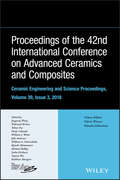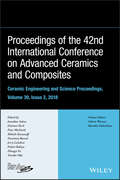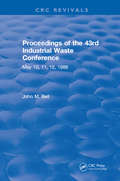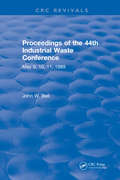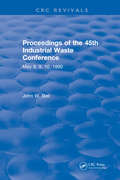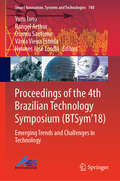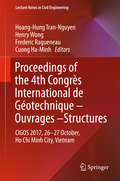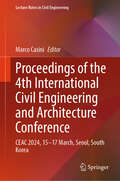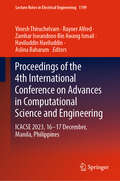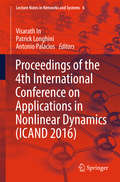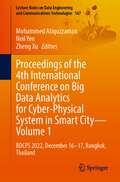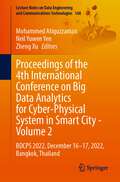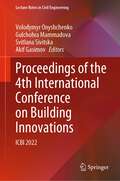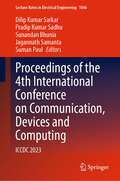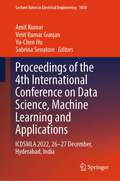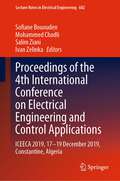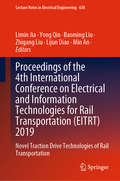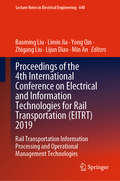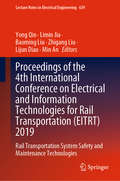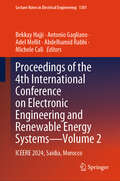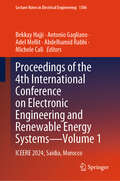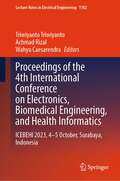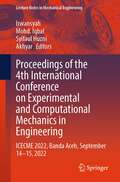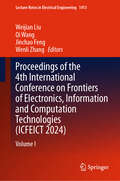- Table View
- List View
Proceedings of the 42nd International Conference on Advanced Ceramics and Composites, Ceramic Engineering and Science Proceedings, (Ceramic Engineering and Science Proceedings #Volume 39, Issue 3)
by Paolo Colombo Soshu Kirihara Waltraud M. Kriven Jingyang Wang William G. Fahrenholtz Michael Halbig Kiyoshi Shimamura Manabu Fukushima Yiquan Wu Jake Amoroso Valerie Wiesner Tobias Fey William J. Weber Kathleen ShurgartProceeding of the 42nd International Conference on Advanced Ceramics and Composites, Ceramic Engineering and Science Proceedings Volume 39, Issue 3, 2018 Jingyang Wang, Waltraud Kriven, Tobias Fey, Paolo Colombo, William J. Weber, Jake Amoroso, William G. Fahrenholtz, Kiyoshi Shimamura, Michael Halbig, Soshu Kirihara, Yiquan Wu, and Kathleen Shurgart, Editors Valerie Wiesner and Manabu Fukushima, Volume Editors This proceedings contains a collection of 22 papers from The American Ceramic Society’s 42nd International Conference on Advanced Ceramics and Composites, held in Daytona Beach, Florida, January 21-26, 2018. This issue includes papers presented in the following symposia: <P><P>• Advancing Frontiers of Ceramics for Sustainable Societal Development – International Symposium in Honor of Dr. Mrityunjay Singh <P><P>• Symposium 9: Porous Ceramics: Novel Developments and Applications <P><P> • Symposium 10: Virtual Materials (Computational) Design and Ceramic Genome <P><P>• Symposium 12 Materials for Extreme Environments: Ultrahigh Temperature Ceramics (UHTCs) and Nano-laminated Ternary Carbides and Nitrides (MAX Phases) <P><P>• Symposium 13 Advanced Ceramics and Composites for Nuclear Fission and Fusion Energy <P><P>• Symposium 14 Crystalline Materials for Electrical, Optical and Medical Applications <P><P>• Symposium 15 Additive Manufacturing and 3D Printing Technologies <P><P>• Symposium 16: Geopolymers, Inorganic Polymers and Sustainable Materials <P><P>• Focused Session 1: Bio-inspired Processing of Advanced Materials <P><P>• 7th Global Young Investigator Forum
Proceedings of the 42nd International Conference on Advanced Ceramics and Composites, Ceramic Engineering and Science Proceedings, Issue 2 (Ceramic Engineering and Science Proceedings)
by Tatsuki Ohji Narottam P. Bansal Jonathan Salem Mihails Kusnezoff Palani Balaya Manabu Fukushima Dietmar Koch Jerry C. LaSalvia Peter Mechnich Zhengyi Fu Valerie WiesnerProceeding of the 42nd International Conference on Advanced Ceramics and Composites, Ceramic Engineering and Science Proceedings Volume 39, Issue 2, 2018 Jonathan Salem, Dietmar Koch, Peter Mechnich, Mihails Kusnezoff, Narottam Bansal, Jerry LaSalvia, Palani Balaya, Zhengyi Fu, and Tatsuki Ohji, Editors Valerie Wiesner and Manabu Fukushima, Volume Editors This proceedings contains a collection of 25 papers from The American Ceramic Society’s 41st International Conference on Advanced Ceramics and Composites, held in Daytona Beach, Florida, January 21-26, 2018. This issue includes papers presented in the following symposia: <P><P>• Symposium 1: Mechanical Behavior and Performance of Ceramics and Composites <P><P> • Symposium 2: Advanced Ceramic Coatings for Structural, Environmental, and Functional Applications <P><P>• Symposium 3: 15th International Symposium on Solid Oxide Fuel Cells (SOFC) <P><P>• Symposium 4: Armor Ceramics: Challenges and New Developments <P><P>• Symposium 6: Advanced Materials and Technologies for Direct Thermal Energy Conversion and Rechargeable Energy Storage <P><P>• Symposium 8: 12th International Symposium on Advanced Processing & Manufacturing
Proceedings of the 43rd Industrial Waste Conference May 1988, Purdue University
by John M. BellThis Purdue volume includes 89 technical papers presented at the 43rd Purdue Industrial Waste Conference, held May 10, 11, and 12, 1988 at Purdue University. The papers address topics within broad categories such as toxic and hazardous wastes; site remediation; landfills; biological systems; sorptive processes; processes and product development; industrial wastes; and laws, regulations, and training. The data and information contained in this volume reflect some of the latest information available on industrial waste and waste management.
Proceedings of the 44th Industrial Waste Conference May 1989, Purdue University
by John W. BellNew research-case histories and operating data-on every conceivable facet of today's big problem are detailed in the latest Purdue Book-with unparalleled appropriate, usable information and data for your current industrial waste problems from the May 1989 Conference.
Proceedings of the 45th Industrial Waste Conference May 1990, Purdue University
by John W. BellNew and timely research, methods, and processes are described in 92 technical papers. This new volume in the Purdue series presents a compendium of valuable information that can be directly applied to today's big problems of environmental control, treatment, regulation, and compliance.
Proceedings of the 4th Brazilian Technology Symposium: Emerging Trends and Challenges in Technology (Smart Innovation, Systems and Technologies #140)
by Yuzo Iano Rangel Arthur Osamu Saotome Hermes José Loschi Vânia Vieira EstrelaThis book presents the Proceedings of The 4th Brazilian Technology Symposium (BTSym'18). Part I of the book discusses current technological issues on Systems Engineering, Mathematics and Physical Sciences, such as the Transmission Line, Protein-modified mortars, Electromagnetic Properties, Clock Domains, Chebyshev Polynomials, Satellite Control Systems, Hough Transform, Watershed Transform, Blood Smear Images, Toxoplasma Gondi, Operation System Developments, MIMO Systems, Geothermal-Photovoltaic Energy Systems, Mineral Flotation Application, CMOS Techniques, Frameworks Developments, Physiological Parameters Applications, Brain Computer Interface, Artificial Neural Networks, Computational Vision, Security Applications, FPGA Applications, IoT, Residential Automation, Data Acquisition, Industry 4.0, Cyber-Physical Systems, Digital Image Processing, Patters Recognition, Machine Learning, Photocatalytic Process, Physical-chemical analysis, Smoothing Filters, Frequency Synthesizers, Voltage Controlled Ring Oscillator, Difference Amplifier, Photocatalysis and Photodegradation. Part II of the book discusses current technological issues on Human, Smart and Sustainable Future of Cities, such as the Digital Transformation, Data Science, Hydrothermal Dispatch, Project Knowledge Transfer, Immunization Programs, Efficiency and Predictive Methods, PMBOK Applications, Logistics Process, IoT, Data Acquisition, Industry 4.0, Cyber-Physical Systems, Fingerspelling Recognition, Cognitive Ergonomics, Ecosystem services, Environmental, Ecosystem services valuation, Solid Waste and University Extension. BTSym is the brainchild of Prof. Dr. Yuzo Iano, who is responsible for the Laboratory of Visual Communications (LCV) at the Department of Communications (DECOM) of the Faculty of Electrical and Computing Engineering (FEEC), State University of Campinas (UNICAMP), Brazil.
Proceedings of the 4th Congrès International de Géotechnique - Ouvrages -Structures
by Henry Wong Hoang-Hung Tran-Nguyen Frederic Ragueneau Cuong Ha-MinhThis proceedings volume for the 4th international conference CIGOS 2017 (Congrès International de Géotechnique - Ouvrages - Structures) presents novel technologies, solutions and research advances, making it an excellent guide in civil engineering for researchers, students, and professional engineers alike. Since 2010, CIGOS has become a vital forum for international scientific exchange on civil engineering. It aims to promote beneficial economic partnerships and technology exchanges between enterprises, worldwide institutions and universities. Following the success of the last three CIGOS conferences (2010, 2013 and 2015), the 4th conference was held at Ho Chi Minh City University of Technology, Ho Chi Minh City (Saigon), Vietnam on 26 to 27 October 2017. The main scientific themes of CIGOS 2017 were focused on ‘New Challenges in Civil Engineering’.
Proceedings of the 4th International Civil Engineering and Architecture Conference: CEAC 2024, 15–17 March, Seoul, South Korea (Lecture Notes in Civil Engineering #534)
by Marco CasiniThis book collects the scientific proceedings presented during the “2024 The 4th International Civil Engineering and Architecture Conference” held in Seoul, South Korea, in March 2024 with the aim of showing the latest advancements in theoretical and applied research in the architecture, engineering, and construction sector (AEC). The book is organized into four main parts, namely (1) sustainable urban planning and architecture; (2) architectural and environmental design; (3) built environment materials and construction technology; and (4) civil engineering and construction management. The goal of the book is to provide readers with an overview of the ongoing transformation of the AEC industry presenting a thorough investigation of the emerging trends in the fields of green building design, construction, and operation.
Proceedings of the 4th International Conference on Advances in Civil and Ecological Engineering Research: ACEER2022 (Lecture Notes in Civil Engineering #292)
by Chih-Huang WengThis book presents select proceedings of the 4th International Conference on Advances in Civil and Ecological Engineering Research (ACEER 2022). The book covers a wide range of topics, including construction engineering and management hydraulic and hydrologic engineering, air quality and atmospheric pollution, ecological risk assessment and management, restoration and protection of environment, water pollution and treatment, and water recourses engineering. This book also covers state-of-the-art technologies in building sustainable city, resilient buildings, and sustainable issues in relating to civil engineering. It will be useful for researchers and engineers working in the field of civil and ecological engineering.
Proceedings of the 4th International Conference on Advances in Computational Science and Engineering: ICACSE 2023, 16–17 December, Manila, Philippines (Lecture Notes in Electrical Engineering #1199)
by Rayner Alfred Haviluddin Haviluddin Zamhar Iswandono Bin Awang Ismail Aslina Baharum Vinesh ThiruchelvamThis book is the proceedings of the 4th International Conference on Advances in Computational Science and Engineering (ICACSE 2023, December 16–17, 2023, Manila, Philippines) and contains the selected peer-reviewed papers which reflect recent achievements in the field of application of the computational methods and algorithms in scientific research and engineering design. The papers presented covered topics such as advances in system integration, high-performance computing, modeling, and simulation, big data analytics, big data visualization, advanced networking and applications, cybersecurity, augmented and virtual reality, artificial intelligence and robotics, soft computing data science, and intelligent knowledge discovery. The book is useful, interesting, and informative for a wide range of scientists, engineers, and students.
Proceedings of the 4th International Conference on Applications in Nonlinear Dynamics (ICAND #2016)
by Visarath In Antonio Palacios Patrick LonghiniThis book presents collaborative research works carried out by experimentalists and theorists around the world in the field of nonlinear dynamical systems. It provides a forum for applications of nonlinear systems while solving practical problems in science and engineering. Topics include: Applied Nonlinear Optics, Sensor, Radar & Communication Signal Processing, Nano Devices, Nonlinear Biomedical Applications, Circuits & Systems, Coupled Nonlinear Oscillator, Precision Timing Devices, Networks, and other contemporary topics in the general field of Nonlinear Science. This book provides a comprehensive report of the various research projects presented at the International Conference on Applications in Nonlinear Dynamics (ICAND 2016) held in Denver, Colorado, 2016. It can be a valuable tool for scientists and engineering interested in connecting ideas and methods in nonlinear dynamics with actual design, fabrication and implementation of engineering applications or devices.>
Proceedings of the 4th International Conference on Big Data Analytics for Cyber-Physical System in Smart City - Volume 1: BDCPS 2022, December 16-17, Bangkok, Thailand (Lecture Notes on Data Engineering and Communications Technologies #167)
by Mohammed Atiquzzaman Zheng Xu Neil YenThis book gathers a selection of peer-reviewed papers presented at the 4th Big Data Analytics for Cyber-Physical System in Smart City (BDCPS 2022) conference, held in Bangkok, Thailand, on December 16–17. The contributions, prepared by an international team of scientists and engineers, cover the latest advances and challenges made in the field of big data analytics methods and approaches for the data-driven co-design of communication, computing, and control for smart cities. Given its scope, it offers a valuable resource for all researchers and professionals interested in big data, smart cities, and cyber-physical systems.
Proceedings of the 4th International Conference on Big Data Analytics for Cyber-Physical System in Smart City - Volume 2: BDCPS 2022, December 16–17, 2022, Bangkok, Thailand (Lecture Notes on Data Engineering and Communications Technologies #168)
by Mohammed Atiquzzaman Zheng Xu Neil Yuwen YenThis book gathers a selection of peer-reviewed papers presented at the 4th Big Data Analytics for Cyber-Physical System in Smart City (BDCPS 2022) conference held in Bangkok, Thailand, on December 16–17. The contributions, prepared by an international team of scientists and engineers, cover the latest advances and challenges made in the field of big data analytics methods and approaches for the data-driven co-design of communication, computing, and control for smart cities. Given its scope, it offers a valuable resource for all researchers and professionals interested in big data, smart cities, and cyber-physical systems.
Proceedings of the 4th International Conference on Building Innovations: ICBI 2022 (Lecture Notes in Civil Engineering #299)
by Volodymyr Onyshchenko Gulchohra Mammadova Svitlana Sivitska Akif GasimovThis book gathers the latest advances, innovations, and applications in the field of building design and construction, by focusing on new design solutions for buildings and new technologies creation for construction, as presented by researchers and engineers at the 4th International Conference Building Innovations (ICBI), held in Poltava – Baku, Ukraine – Azerbaijan, on May 19-20, 2022. It covers highly diverse topics, including structures operation, repairing and thermal modernization in existing buildings and urban planning features, machines and mechanisms for construction, as well as efficient economy and energy conservation issues in construction. The contributions, which were selected by means of a rigorous international peer-review process, highlight numerous exciting ideas that will spur novel research directions and foster multidisciplinary collaborations.
Proceedings of the 4th International Conference on Communication, Devices and Computing: ICCDC 2023 (Lecture Notes in Electrical Engineering #1046)
by Pradip Kumar Sadhu Suman Paul Dilip Kumar Sarkar Jagannath Samanta Sunandan BhuniaThe book is a collection of best selected research papers presented at the Fourth International Conference on Communication, Devices and Computing (ICCDC 2023). The book covers new ideas, applications and experiences of research engineers, scientists, industrialists, scholars and students from in and around the globe. It covers research contributions from communication technologies which are from the areas such as 5G communication, next-generation Wi-Fi, spread spectrum systems, satellite and high altitude platforms, radio over fiber techniques, wireless sensor networks, modulation and diversity technique, ad hoc and mesh networks, cognitive radio networking, optical wireless and visible light communications, signal processing for secure communication, millimeter wave and terahertz communication, design, control and management of optical network, error control coding and information theory, printed antennas, performance analysis of wireless network, smart antennas and space time processing.
Proceedings of the 4th International Conference on Data Science, Machine Learning and Applications: ICDSMLA 2022, 26–27 December, Hyderabad, India (Lecture Notes in Electrical Engineering #1038)
by Amit Kumar Yu-Chen Hu Vinit Kumar Gunjan Sabrina SenatoreThis book includes peer reviewed articles from the 4th International Conference on Data Science, Machine Learning and Applications, 2022, held at the Hyderabad Institute of Technology & Management on 26-27th December, India. ICDSMLA is one of the most prestigious conferences conceptualized in the field of Data Science & Machine Learning offering in-depth information on the latest developments in Artificial Intelligence, Machine Learning, Soft Computing, Human Computer Interaction, and various data science & machine learning applications. It provides a platform for academicians, scientists, researchers and professionals around the world to showcase broad range of perspectives, practices, and technical expertise in these fields. It offers participants the opportunity to stay informed about the latest developments in data science and machine learning.
Proceedings of the 4th International Conference on Electrical Engineering and Control Applications: ICEECA 2019, 17–19 December 2019, Constantine, Algeria (Lecture Notes in Electrical Engineering #682)
by Ivan Zelinka Mohammed Chadli Sofiane Bououden Salim ZianiThis book gathers papers presented during the 4th International Conference on Electrical Engineering and Control Applications. It covers new control system models, troubleshooting tips and complex system requirements, such as increased speed, precision and remote capabilities. Additionally, the papers discuss not only the engineering aspects of signal processing and various practical issues in the broad field of information transmission, but also novel technologies for communication networks and modern antenna design. This book is intended for researchers, engineers and advanced postgraduate students in the fields of control and electrical engineering, computer science and signal processing, as well as mechanical and chemical engineering.
Proceedings of the 4th International Conference on Electrical and Information Technologies for Rail Transportation: Novel Traction Drive Technologies of Rail Transportation (Lecture Notes in Electrical Engineering #638)
by Zhigang Liu Limin Jia Yong Qin Lijun Diao Min An Baoming LiuThis book reflects the latest research trends, methods and experimental results in the field of electrical and information technologies for rail transportation, which covers abundant state-of-the-art research theories and ideas. As a vital field of research that is highly relevant to current developments in a number of technological domains, the subjects it covered include intelligent computing, information processing, Communication Technology, Automatic Control, etc. The objective of the proceedings is to provide a major interdisciplinary forum for researchers, engineers, academicians as well as industrial professionals to present the most innovative research and development in the field of rail transportation electrical and information technologies. Engineers and researchers in academia, industry, and the government will also explore an insight view of the solutions that combine ideas from multiple disciplines in this field. The volumes serve as an excellent reference work for researchers and graduate students working on rail transportation, electrical and information technologies.
Proceedings of the 4th International Conference on Electrical and Information Technologies for Rail Transportation: Rail Transportation Information Processing and Operational Management Technologies (Lecture Notes in Electrical Engineering #640)
by Zhigang Liu Limin Jia Yong Qin Lijun Diao Min An Baoming LiuThis book reflects the latest research trends, methods and experimental results in the field of electrical and information technologies for rail transportation, which covers abundant state-of-the-art research theories and ideas. As a vital field of research that is highly relevant to current developments in a number of technological domains, the subjects it covered include intelligent computing, information processing, Communication Technology, Automatic Control, etc. The objective of the proceedings is to provide a major interdisciplinary forum for researchers, engineers, academicians as well as industrial professionals to present the most innovative research and development in the field of rail transportation electrical and information technologies. Engineers and researchers in academia, industry, and the government will also explore an insight view of the solutions that combine ideas from multiple disciplines in this field. The volumes serve as an excellent reference work for researchers and graduate students working on rail transportation, electrical and information technologies.
Proceedings of the 4th International Conference on Electrical and Information Technologies for Rail Transportation: Rail Transportation System Safety and Maintenance Technologies (Lecture Notes in Electrical Engineering #639)
by Zhigang Liu Limin Jia Yong Qin Lijun Diao Min An Baoming LiuThis book reflects the latest research trends, methods and experimental results in the field of electrical and information technologies for rail transportation, which covers abundant state-of-the-art research theories and ideas. As a vital field of research that is highly relevant to current developments in a number of technological domains, the subjects it covered include intelligent computing, information processing, Communication Technology, Automatic Control, etc. The objective of the proceedings is to provide a major interdisciplinary forum for researchers, engineers, academicians as well as industrial professionals to present the most innovative research and development in the field of rail transportation electrical and information technologies. Engineers and researchers in academia, industry, and the government will also explore an insight view of the solutions that combine ideas from multiple disciplines in this field. The volumes serve as an excellent reference work for researchers and graduate students working on rail transportation, electrical and information technologies.
Proceedings of the 4th International Conference on Electronic Engineering and Renewable Energy Systems - Volume 2: ICEERE 2024, Saidia, Morocco (Lecture Notes in Electrical Engineering #1301)
by Bekkay Hajji Abdelhamid Rabhi Adel Mellit Antonio Gagliano Michele CalìThis book includes papers presented at the 4th International Conference on Electronic Engineering and Renewable Energy (ICEERE 2024), held in Saidia, Morocco, which focus on the application of artificial intelligence techniques, emerging technology, and the Internet of things in electrical and renewable energy systems, including hybrid systems, micro-grids, networking, smart health applications, smart grid, mechatronics, and electric vehicles. It particularly focuses on new renewable energy technologies for agricultural and rural areas to promote the development of the Euro-Mediterranean region. Given its scope, the book is of interest to graduate students, researchers, and practicing engineers working in the fields of electronic engineering and renewable energy. The book represents Volume 2 for this conference proceedings, which consists of a 2-volume book series
Proceedings of the 4th International Conference on Electronic Engineering and Renewable Energy Systems—Volume 1: ICEERE 2024, Saidia, Morocco (Lecture Notes in Electrical Engineering #1306)
by Bekkay Hajji Abdelhamid Rabhi Adel Mellit Antonio Gagliano Michele CalìThis book includes papers presented at the 4th International Conference on Electronic Engineering and Renewable Energy (ICEERE 2024), held in Saidia, Morocco, which focus on the application of artificial intelligence techniques, emerging technology, and the Internet of things in electrical and renewable energy systems, including hybrid systems, micro-grids, networking, smart health applications, smart grid, mechatronics, and electric vehicles. It particularly focuses on new renewable energy technologies for agricultural and rural areas to promote the development of the Euro-Mediterranean region. Given its scope, the book is of interest to graduate students, researchers, and practicing engineers working in the fields of electronic engineering and renewable energy. The book represents Volume 1 for this conference proceedings, which consist of a 2-volume book series
Proceedings of the 4th International Conference on Electronics, Biomedical Engineering, and Health Informatics: ICEBEHI 2023, 4–5 October, Surabaya, Indonesia (Lecture Notes in Electrical Engineering #1182)
by Achmad Rizal Wahyu Caesarendra Triwiyanto TriwiyantoThis book presents high-quality peer-reviewed papers from the International Conference on Electronics, Biomedical Engineering, and Health Informatics (ICEBEHI 2023, October 4–5, Surabaya, Indonesia). The contents are broadly divided into three main topics (a) Electronics, (b) Biomedical Engineering, and (c) Health Informatics. The major focus is on emerging technologies and their applications in the domain of biomedical engineering. It includes papers based on original theoretical, practical, and experimental simulations, development, applications, measurements, and testing. Featuring the latest advances in the field of biomedical engineering applications, this book serves as a definitive reference resource for researchers, professors, and practitioners interested in exploring advanced techniques in the field of electronics, biomedical engineering, and health informatics. The applications and solutions discussed here provide excellent reference material for future product development.
Proceedings of the 4th International Conference on Experimental and Computational Mechanics in Engineering: ICECME 2022, Banda Aceh, September 14–15, 2022 (Lecture Notes in Mechanical Engineering)
by Akhyar Syifaul Huzni Irwansyah Mohd. IqbalThis book gathers a selection of peer-reviewed papers presented at the 4th International Conference on Experimental and Computational Mechanics in Engineering (ICECME 2022), held as a virtual conference and organized by Universitas Syiah Kuala, Banda Aceh, Indonesia, on September 14–15, 2022.This book, prepared by international scientists and engineers, covers the latest advances in computational mechanics, metallurgy and material science, energy systems, manufacturing processing systems, industrial and system engineering, biomechanics, artificial intelligence, micro-/nano-engineering, micro-electro-mechanical system, machine learning, mechatronics, and engineering design. This book is intended for academics, including graduate students and researchers, as well as industrial practitioners working in the areas of experimental and computational mechanics.
Proceedings of the 4th International Conference on Frontiers of Electronics, Information and Computation Technologies: Volume I (Lecture Notes in Electrical Engineering #1413)
by Qi Wang Wenli Zhang Weijian Liu Jinchao FengThis book contains papers that have been carefully compiled from the fourth International Conference on Frontiers of Electronics, Information and Computation Technologies (ICFEICT), which was held in Beijing from June 22 to June 24, 2024. These papers have undergone rigorous review processes and adhere to strict standards. The primary goal of the conference is to promote research and development efforts in these areas while fostering the exchange of scientific information. The intended audience for the papers presented at ICFEICT 2024 will primarily be leading academic scientists, researchers, scholars, educators, developers, engineers, students, and practitioners working globally in the areas of electronics engineering, communications, and computing.
